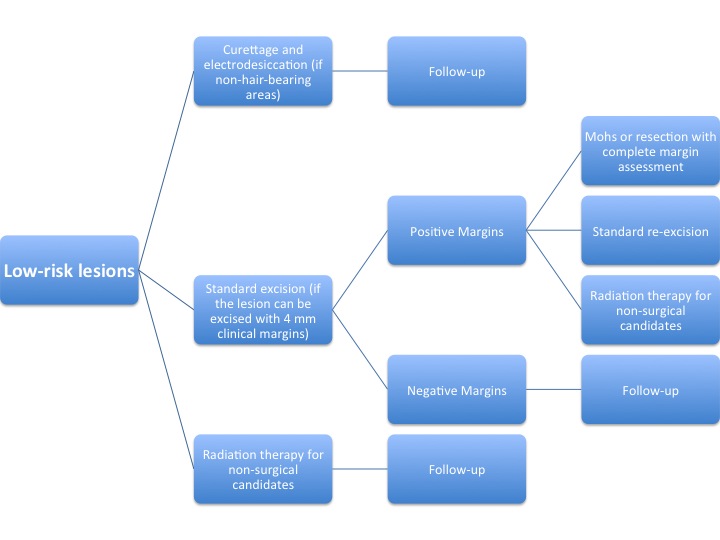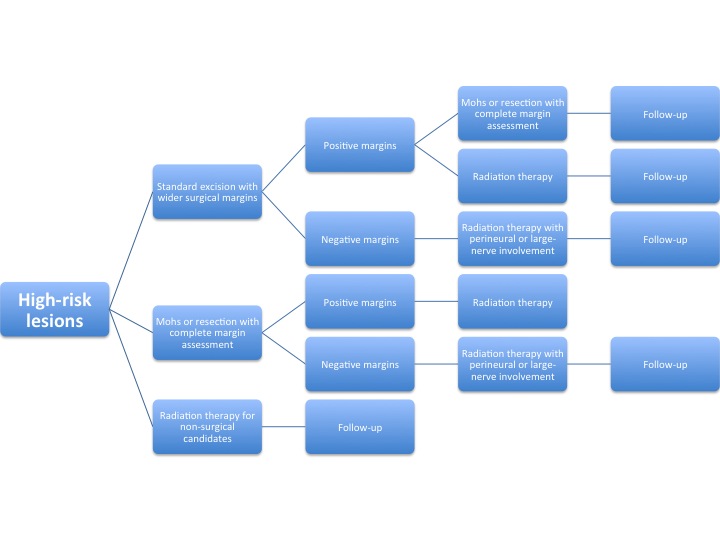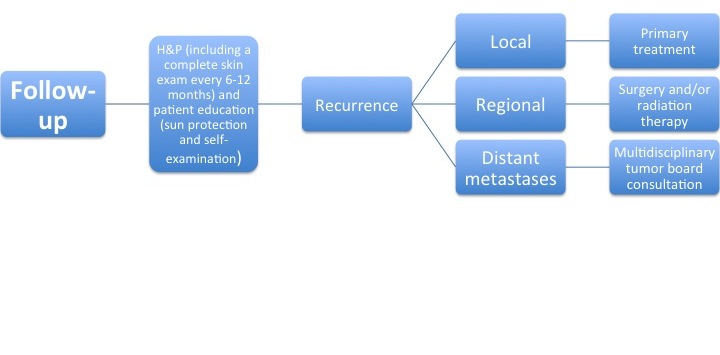Basal cell carcinoma medical therapy: Difference between revisions
| Line 51: | Line 51: | ||
'''Area M''' = [[cheeks]], [[forehead]], [[scalp]], [[neck]], and pre-[[tibial]] area | '''Area M''' = [[cheeks]], [[forehead]], [[scalp]], [[neck]], and pre-[[tibial]] area | ||
'''Area L''' = [[trunk]] and [[extremities]] (excluding pre-tibial area, [[hands]], [[feet]], [[nail]] units, and ankles) | '''Area L''' = [[trunk]] and [[extremities]] (excluding pre-[[tibial]] area, [[hands]], [[feet]], [[nail]] units, and ankles) | ||
The algorithm below demonstrates a treatment protocol for '''low-risk''' lesions<ref>http://www.nccn.org/professionals/physician_gls/PDF/nmsc.pdf</ref>. | The [[Algorithm (medical)|algorithm]] below demonstrates a treatment [[Protocol (natural sciences)|protocol]] for '''low-risk''' [[lesions]]<ref>http://www.nccn.org/professionals/physician_gls/PDF/nmsc.pdf</ref>. | ||
[[Image:Low Risk Basal Cell.jpg|800px]] | [[Image:Low Risk Basal Cell.jpg|800px]] | ||
The algorithm below demonstrates a treatment protocol for '''high-risk''' lesions<ref>http://www.nccn.org/professionals/physician_gls/PDF/nmsc.pdf</ref>. | The [[algorithm]] below demonstrates a treatment [[Protocol (natural sciences)|protocol]] for '''high-risk''' [[lesions]]<ref>http://www.nccn.org/professionals/physician_gls/PDF/nmsc.pdf</ref>. | ||
[[Image:High Risk Basal Cell.jpg|800px]] | [[Image:High Risk Basal Cell.jpg|800px]] | ||
After the primary treatment, a follow-up is performed to evaluate for recurrence of the tumor. | After the primary treatment, a follow-up is performed to evaluate for recurrence of the [[tumor]]. | ||
The algorithm below demonstrates a follow-up protocol<ref>http://www.nccn.org/professionals/physician_gls/PDF/nmsc.pdf</ref>. | The [[algorithm]] below demonstrates a follow-up [[Protocol (natural sciences)|protocol]]<ref>http://www.nccn.org/professionals/physician_gls/PDF/nmsc.pdf</ref>. | ||
[[Image:Followup Basal Cell.jpg|800px]] | [[Image:Followup Basal Cell.jpg|800px]] | ||
| Line 74: | Line 74: | ||
*Imiquimoid | *Imiquimoid | ||
**It is an [[immunomodulatory]] agent that binds to [[Toll-like receptors|toll-like receptor]] 7 and induces the release of pro-[[inflammatory]] [[cytokines]] including [[IFN-α|IFN]]-alpha, [[TNF-alpha]] and [[IL-12]]. | **It is an [[immunomodulatory]] agent that binds to [[Toll-like receptors|toll-like receptor]] 7 and induces the release of pro-[[inflammatory]] [[cytokines]] including [[IFN-α|IFN]]-alpha, [[TNF-alpha]] and [[IL-12]]. | ||
**It is approved for treatment of small [[superficial]] | **It is approved for treatment of small [[superficial]] basal cell carcinoma and is applied nightly five times a week for six weeks. | ||
**The complete [[cure]] rate was around 80%. | **The complete [[cure]] rate was around 80%. | ||
*[[Photodynamic therapy]] | *[[Photodynamic therapy]] | ||
**The other available option for | **The other available option for basal cell carcinoma is [[photodynamic therapy]] (PDT) with [[Levulinic acid|5-amino levulinic acid]](MAL) or with its methyl [[Esters|ester]] plus red light. | ||
**The MAL [[Cream (pharmaceutical)|cream]] is applied to the [[tumor]] and covered with an [[Occlusive dressing|occlusive]] [[Dressing (medical)|dressing]] for three hours. | **The MAL [[Cream (pharmaceutical)|cream]] is applied to the [[tumor]] and covered with an [[Occlusive dressing|occlusive]] [[Dressing (medical)|dressing]] for three hours. | ||
**The [[Tumor cell|tumor cells]] then form increasing amounts of [[protoporphyrin IX]], which is stimulated by [[irradiation]] with red [[light]] to form [[reactive oxygen species]] which are in turn [[cytotoxic.]] | **The [[Tumor cell|tumor cells]] then form increasing amounts of [[protoporphyrin IX]], which is stimulated by [[irradiation]] with red [[light]] to form [[reactive oxygen species]] which are in turn [[cytotoxic.]] | ||
Revision as of 16:33, 1 March 2019
|
Basal cell carcinoma Microchapters |
|
Diagnosis |
|---|
|
Case Studies |
|
Basal cell carcinoma medical therapy On the Web |
|
American Roentgen Ray Society Images of Basal cell carcinoma medical therapy |
|
Risk calculators and risk factors for Basal cell carcinoma medical therapy |
Editor-In-Chief: C. Michael Gibson, M.S., M.D. [1] Associate Editor(s)-in-Chief: Saarah T. Alkhairy, M.D.
Overview
After the suspicious lesion is evaluated, the medical therapy is divided into low-risk and high-risk basal cell carcinoma patients. Medical therapy consists of surgery, radiation therapy, and follow-up for recurrence.
Basal Cell Carcinoma Medical Therapy
Once the suspicious lesion is evaluated, the medical therapy is based upon the low-risk and high-risk basal cell carcinoma patients.
The table below summarizes the characteristics in low-risk and high-risk lesions[1].
| H&P | Low Risk | High Risk |
| Location/size | Area L < 20 mm; Area M < 10 mm; Area H < 6 mm | Area L ≥ 20 mm; Area M ≥ 10 mm; Area H ≥ 6 mm |
| Borders | Well defined | Poorly defined |
| Primary vs. recurrent | Primary | Recurrent |
| Immunosuppression | (-) | (+) |
| Site of prior radiation therapy | (-) | (+) |
| Subtype | Nodular, superficial | Aggressive growth pattern |
| Perineural involvement | (-) | (+) |
Area H = “mask areas” of face (central face, eyelids, eyebrows, periorbital, nose, lips [cutaneous and vermilion], chin, mandible, preauricular and postauricular skin/sulci, temple, ear), genitalia, hands, and feet
Area M = cheeks, forehead, scalp, neck, and pre-tibial area
Area L = trunk and extremities (excluding pre-tibial area, hands, feet, nail units, and ankles)
The algorithm below demonstrates a treatment protocol for low-risk lesions[2].
The algorithm below demonstrates a treatment protocol for high-risk lesions[3].
After the primary treatment, a follow-up is performed to evaluate for recurrence of the tumor.
The algorithm below demonstrates a follow-up protocol[4].
The medical therapy for basal cell carcinoma is divided into[5][6]:
- Toipcal
- Systemic
Topical therapy
- Imiquimoid
- It is an immunomodulatory agent that binds to toll-like receptor 7 and induces the release of pro-inflammatory cytokines including IFN-alpha, TNF-alpha and IL-12.
- It is approved for treatment of small superficial basal cell carcinoma and is applied nightly five times a week for six weeks.
- The complete cure rate was around 80%.
- Photodynamic therapy
- The other available option for basal cell carcinoma is photodynamic therapy (PDT) with 5-amino levulinic acid(MAL) or with its methyl ester plus red light.
- The MAL cream is applied to the tumor and covered with an occlusive dressing for three hours.
- The tumor cells then form increasing amounts of protoporphyrin IX, which is stimulated by irradiation with red light to form reactive oxygen species which are in turn cytotoxic.
- It should be repeated after 1–4 weeks.
- The achieved complete remission is expected to be 92%.
- The main disadvantages of photodynamic therapy are the pain during the irradiation and the local inflammatory reaction (erythema, erosions, pustules, and crusts).
- 5-flurouracil
- It is a cytostatic agent which is available as a 5% prescription cream that is designed to be applied twice daily for 3–12 weeks until erosions develop.
Systemic therapy
- Sonic hedgehog pathway inhibitors(vismodegib, sonidegib)
- They are markedly teratogenic and embryotoxic.
- The commonest adverse effects of vismodegib include muscle cramps, hair loss, taste disturbances and weight loss.
Cryotherapy
- Small and superficial basal cell carcinoma is occasionally still treated with liquid nitrogen (–196°C) either with direct contact or using a spray.
- The wounds may heal with either hypopigmentation or scarring so making it a major disadvantage.
References
- ↑ http://www.nccn.org/professionals/physician_gls/PDF/nmsc.pdf
- ↑ http://www.nccn.org/professionals/physician_gls/PDF/nmsc.pdf
- ↑ http://www.nccn.org/professionals/physician_gls/PDF/nmsc.pdf
- ↑ http://www.nccn.org/professionals/physician_gls/PDF/nmsc.pdf
- ↑ Berking C, Hauschild A, Kölbl O, Mast G, Gutzmer R (May 2014). "Basal cell carcinoma-treatments for the commonest skin cancer". Dtsch Arztebl Int. 111 (22): 389–95. doi:10.3238/arztebl.2014.0389. PMID 24980564.
- ↑ Wong CS, Strange RC, Lear JT (October 2003). "Basal cell carcinoma". BMJ. 327 (7418): 794–8. doi:10.1136/bmj.327.7418.794. PMC 214105. PMID 14525881.


